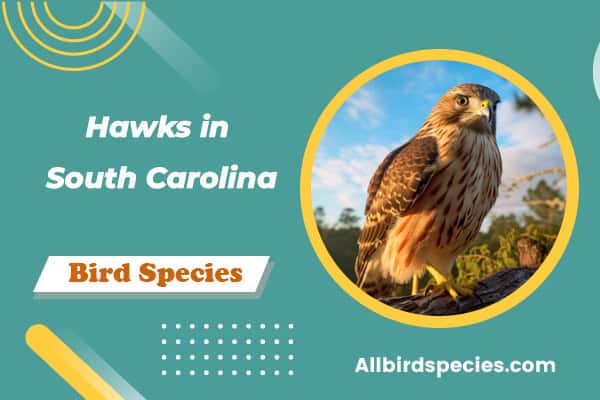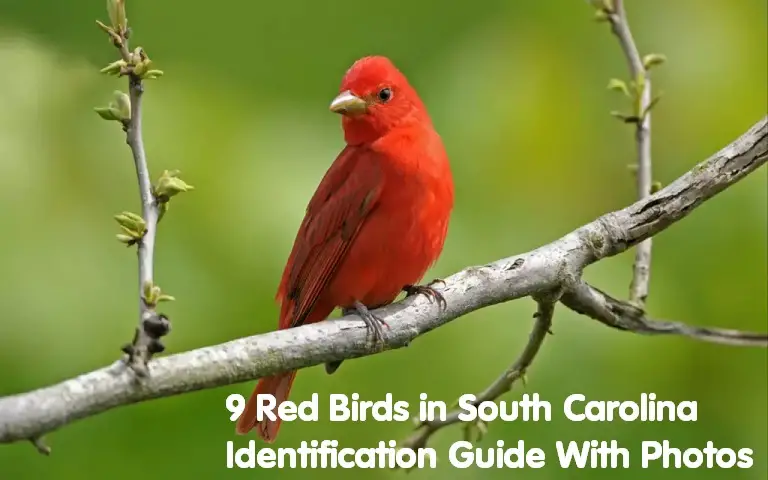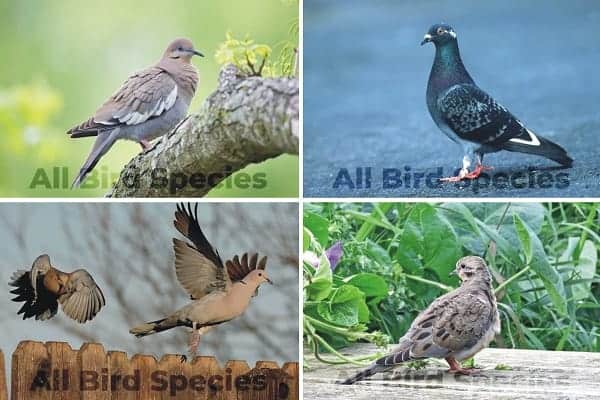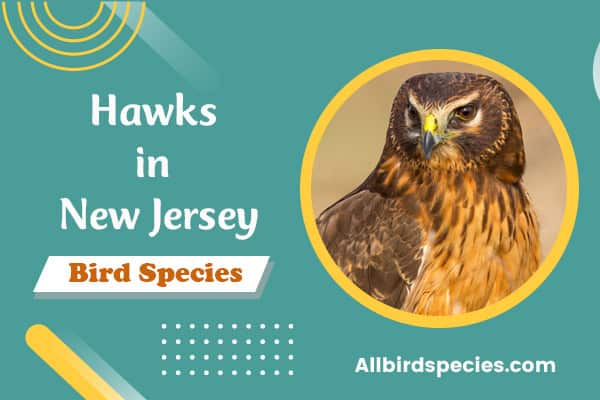6 Types Of Hawks in South Carolina (ID Guide With Pictures)
Do you know how many different types of hawk species live in South Carolina? I’ve researched Hawks in South Carolina and discovered some fascinating details. Also, These birds are not just skilled hunters but also have a unique role in the ecosystem. You might be surprised by how they adapt to their environment. Their hunting techniques and behaviors reveal a lot about the balance of nature. Let me share what I’ve learned about these incredible raptors. Dive in to explore their world with me.
Common Hawk Species in South Carolina
- Red-Tailed Hawk
- Cooper’s Hawk
- Sharp-Shinned Hawk
- Broad-Winged Hawk
- Northern Harrier
- Red-Shouldered Hawk
So, let’s explore each one in detail.
1. Red-Tailed Hawk
- Scientific name: Buteo jamaicensis
- Life span: 10-15 years
- Size: 19.7-25.6 in (50-65 cm)
- Weight: 31.8-51.5 oz (900-1460 g)
- Wingspan: 44.9-52.4 in (114-133 cm)
- State status: Breeding and common
The Red-tailed Hawk is a common bird in South Carolina. You can often see it sitting high in trees or flying over fields. Its wide wings and red tail are easy to recognize. The hawk’s brown body and light-colored belly stand out against South Carolina’s different landscapes.

The Red-tailed Hawk lives in South Carolina all year. It represents the state’s open spaces and shows how nature can adapt. The Red-tailed Hawk, a symbol of the open skies, likes to build its nests in tall trees and on high cliffs in South Carolina. These nests, made of sticks and plants, are often used and rebuilt every year.
These hawks are very loyal to their nesting sites, coming back to the same place year after year. Watching them care for their young is amazing. Both parents help feed and teach the baby hawks how to fly and hunt.
The Red-tailed Hawk eats many different animals, showing how rich South Carolina’s ecosystems are. They eat small mammals like rabbits and squirrels, reptiles, and even dead animals. This varied diet helps them live in many places, from farms to cities.
2. Cooper’s Hawk
- Scientific name: Accipiter cooperii
- Life span: 12 years
- Size: 14.6-15.3 in (37-39 cm)
- Weight: 7.8-14.5 oz (220-410 g)
- Wingspan: 24.4-35.4 in (62-90 cm)
- State status: Migratory and common
Cooper’s Hawk is a common sight in South Carolina’s woodlands. It stands out with its blue-gray back and red-orange chest, making it easy to spot against the green. Also, This bird expertly navigates through dense forest areas, especially in winter.

Cooper’s Hawks build their nests high in tall trees using sticks and bark, often reusing them year after year. Both parents care for their young until they are ready to fly on their own.
Also, These hawks are skilled hunters, mostly catching smaller birds, but they also eat small mammals and insects. Their speed and agility make them impressive hunters in the forest.
3. Sharp-Shinned Hawk
- Scientific name: Accipiter striatus
- Life span: 5 years
- Size: 9.4-13.4 in (24-34 cm)
- Weight: 3.1-7.7 oz (87-218 g)
- Wingspan: 16.9-22.1 in (43-56 cm)
- State status: Migratory and rare
The Sharp-shinned Hawk, the smallest hawk in South Carolina, visits in winter and adds a touch of mystery to the birdwatching scene. With its blue-gray back and striped underside, it brings a splash of color to the winter woods.

This hawk is often hard to spot, quickly darting through the trees with great speed. It reminds us of the diverse bird life in South Carolina.
The Sharp-shinned Hawks in South Carolina prefer to nest in dense forests, where it’s hidden and safe. Its nests are small but carefully built with twigs, bark, and leaves. The parents are very dedicated, taking great care of their young from hatching until they can fly.
These hawks are skilled hunters, catching small birds in mid-air with impressive agility.
Hawks In other Regions:
4. Broad-Winged Hawk
- Scientific name: Buteo platypterus
- Life span: 12 years
- Size: 13.4-17.3 in (34-44 cm)
- Weight: 9.3-19.8 oz (265-560 g)
- Wingspan: 31.9-39.4 in (81-100 cm)
- State status: Breeding and rare
The Broad-winged Hawk lives in South Carolina’s forests and blends in with its brown back and banded tail. Though small and camouflaged, it’s a highlight during migration with its white and brown-streaked underparts.

In spring, these hawks turn their nesting grounds in the northwest into a busy place before heading to South America. Their nests, built high in trees with twigs and softer materials, become home to their eggs. Both parents take turns incubating and caring for the chicks.
Broad-winged Hawks are skilled hunters, eating small mammals like voles and mice, and sometimes amphibians, insects, and small birds. Thanks to conservation efforts, including habitat protection and better pesticide controls, their numbers are on the rise.
Related Video:
5. Northern Harrier
- Scientific name: Circus hudsonius
- Life span: Up to 12 years
- Size: 18-20 inches (45-50 cm)
- Weight: 12-26 ounces (350-740 g)
- Wingspan: 40-48 inches (100-122 cm)
- State status: Migratory and uncommon
The Northern Harrier, a striking bird of prey, is a familiar sight in South Carolina’s open fields and marshes. With its distinctive white rump and graceful, low-flying hunting style, this hawk stands out against the landscape. Its broad wings and long tail help it glide effortlessly as it searches for prey.

In South Carolina, the Northern Harrier is most noticeable in winter. Its hunting grounds are often open areas where it can spot small mammals and birds from above. This harrier’s unique hunting technique, flying close to the ground and using its keen eyesight, makes it a skilled predator.
During nesting season, Northern Harriers build their nests on the ground, usually in tall grasses or reeds. The female takes the lead in incubating the eggs, while the male brings food to her. After the eggs hatch, both parents care for the young, teaching them how to hunt and survive.
Despite some past challenges with habitat loss and pesticide use, conservation efforts are helping to protect their habitats and support their populations. The Northern Harrier remains a symbol of the open landscapes and diverse wildlife in South Carolina.
6. Red-Shouldered Hawk
- Scientific name: Circus hudsonius
- Life span: Up to 12 years
- Size: 18-20 inches (45-50 cm)
- Weight: 12-26 ounces (350-740 g)
- Wingspan: 40-48 inches (100-122 cm)
- State status: Breeding and common
The Red-shouldered Hawk is a vibrant presence in South Carolina’s woodlands. Its striking reddish shoulders and distinctive call make it a standout in the forest. This medium-sized hawk is known for its dramatic flight patterns and impressive hunting skills.

In South Carolina, you can spot the Red-shouldered Hawk year-round, especially in wooded areas near water. It builds its nest high in trees, where it weaves a sturdy structure from sticks and lines it with softer materials. Both parents are involved in raising their young, with the female incubating the eggs and the male providing food.
These hawks primarily hunt small mammals, birds, and amphibians, using their sharp talons and keen eyesight to spot prey from above. Conservation efforts have helped maintain their populations, ensuring that the Red-shouldered Hawk continues to be a colorful and important part of South Carolina’s birdlife.
Where to find Hawks in South Carolina
Hawks are powerful birds known for their sharp eyesight and smooth flying. You can find them all over South Carolina, where different types of hawks, like Red-tailed Hawks, Cooper’s Hawks, and Sharp-shinned Hawks, live in various environments.
If you want to see hawks in South Carolina, a good strategy is to visit places where they might hunt or nest. Hawks often hunt in open areas like fields and meadows, but you can also find them in forests and wetlands. They are usually spotted flying high in the sky, looking for prey on the ground, or perched on tall trees or poles.
Here are four great places in South Carolina to watch hawks:
- Congaree National Park: This park has a mix of woodlands and waterways, making it a perfect home for hawks.
- Huntington Beach State Park: This coastal park is full of different kinds of birds, and you might see hawks near the marshy areas.
- Caesars Head State Park: In the upstate region, this park’s high elevation and rocky landscape make it a good place to see hawks, especially when they are migrating.
- Ace Basin National Wildlife Refuge: This large protected area, with its wetlands, forests, and estuaries, is a great environment for hawks and other birds of prey.
To increase your chances of seeing hawks, it’s a good idea to bring binoculars or a spotting scope. Early morning or late afternoon are the best times for birdwatching because that’s when birds are most active. Also, joining a local birdwatching group or going on guided tours can make your experience more enjoyable and help you spot these amazing birds more easily.
Check our Previous Articles:
- Black Redstart
- Cuckoo bird- Cuculidae Family
- Indian Runner Ducks
- Sparrows in Illinois
- Types of Cardinals
Wrapping Up…
The skies of South Carolina are home to a wide variety of hawks, each playing a special role in the state’s ecosystem. For example, Broad-winged Hawks prefer forest canopies, while Northern Harriers are often seen gliding over marshlands, showcasing the delicate balance of nature.
These hawks have different diets, and nesting habits, and show great resilience, which highlights the need to protect them. By continuing to preserve their habitats, we help ensure that these powerful symbols of wild freedom continue to soar for many years to come.







